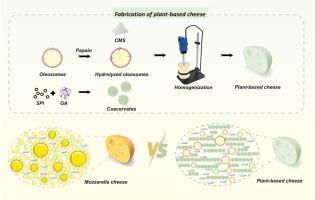植物奶酪的复杂凝聚与丰富的油脂体
IF 11
1区 农林科学
Q1 CHEMISTRY, APPLIED
引用次数: 0
摘要
随着绿色健康饮食习惯在消费者中越来越受欢迎,植物奶酪作为一种新兴的植物性产品受到了广泛关注。由于植物性产品的成分复杂性和结构异质性,复制乳制品奶酪的感官、营养和物理化学特性仍然是一个关键的挑战。本研究开发了一种基于复杂凝聚的植物奶酪,富集了油脂体,并研究了植物成分在其微观结构、质地和水分分布中的作用。植物基奶酪表现出优异的拉伸性和可调的流变性能。木瓜蛋白酶水解的油质体通过改善基质和优化脂肪分布,显著提高了植物奶酪的水结合能力和结构稳定性。LF-NMR分析表明,大豆分离蛋白(SPI)/阿拉伯胶(GA)凝聚体的加入增强了水的结合,降低了水的流动性,从而影响了植物奶酪的质地。本研究强调了复杂凝聚在设计具有良好质地特性和控制水分分布的植物基奶酪方面的潜力,为新型植物基奶酪提供了新的见解。本文章由计算机程序翻译,如有差异,请以英文原文为准。

Plant cheese based on complex coacervation with enrichment of oleosomes
As green and healthy dietary habit become increasingly popular among consumers, plant-based cheese has gained widespread attention as an emerging plant-based product. Replicating the sensory, nutritional, and physicochemical properties of dairy cheese remains a critical challenge due to the compositional complexity and structural heterogeneity of plant-based products. This study developed plant cheese based on complex coacervation with enrichment of oleosomes and the roles of plant-based ingredients in shaping its microstructure, texture, and moisture distribution were examined. The plant-based cheese exhibited excellent stretchability and tunable rheological properties. Papain hydrolyzed oleosomes significantly enhanced the water-binding capacity and structural stability of plant-based cheese by improving the matrix and optimizing the fat distribution. LF-NMR analysis revealed that the addition of soy protein isolate (SPI)/gum arabic (GA) coacervates enhanced the binding of water, reducing its mobility, which in turn affected the texture of the plant-based cheese. This study highlights the potential of complex coacervation to design plant-based cheeses with favorable textural properties and controlled water distribution, offering new insights for novel plant-based cheeses.
求助全文
通过发布文献求助,成功后即可免费获取论文全文。
去求助
来源期刊

Food Hydrocolloids
工程技术-食品科技
CiteScore
19.90
自引率
14.00%
发文量
871
审稿时长
37 days
期刊介绍:
Food Hydrocolloids publishes original and innovative research focused on the characterization, functional properties, and applications of hydrocolloid materials used in food products. These hydrocolloids, defined as polysaccharides and proteins of commercial importance, are added to control aspects such as texture, stability, rheology, and sensory properties. The research's primary emphasis should be on the hydrocolloids themselves, with thorough descriptions of their source, nature, and physicochemical characteristics. Manuscripts are expected to clearly outline specific aims and objectives, include a fundamental discussion of research findings at the molecular level, and address the significance of the results. Studies on hydrocolloids in complex formulations should concentrate on their overall properties and mechanisms of action, while simple formulation development studies may not be considered for publication.
The main areas of interest are:
-Chemical and physicochemical characterisation
Thermal properties including glass transitions and conformational changes-
Rheological properties including viscosity, viscoelastic properties and gelation behaviour-
The influence on organoleptic properties-
Interfacial properties including stabilisation of dispersions, emulsions and foams-
Film forming properties with application to edible films and active packaging-
Encapsulation and controlled release of active compounds-
The influence on health including their role as dietary fibre-
Manipulation of hydrocolloid structure and functionality through chemical, biochemical and physical processes-
New hydrocolloids and hydrocolloid sources of commercial potential.
The Journal also publishes Review articles that provide an overview of the latest developments in topics of specific interest to researchers in this field of activity.
 求助内容:
求助内容: 应助结果提醒方式:
应助结果提醒方式:


